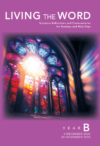Scripture Study for
First Sunday of Advent
Isaiah 2:1–5 / Psalm 122:1 / Romans 13: 11–14 / Matthew 24: 37–44
<< Back to LECTIONARY RESOURCES
Understanding the Word
By Dianne Bergant, C.S.A.
The first reading contains a vision of universal peace and an invitation to participate in that peace through faithfulness to God’s word. The image of the reign of God found in the reading from Isaiah is of a city, not known for its political prominence or military might, but revered as the dwelling place of God. This is a vision of the future reign of God, of an eschatological age of complete faithfulness to God and the peace and harmony among people that will flow from it.
Paul, too, speaks about the reign of God, but from a different perspective. He tells the Roman Christians that they are living in a decisive moment, the kairós, the period of transition from the age of sin to the long-awaited age of fulfillment. Paul employs several images to characterize this division of time. He says that this age is like slumber, or night and darkness, while the age to come is like wakefulness, or day and light. He urges the Christians to wake from sleep and to live in faithful
ness. The apparent incongruity between these two ages exemplifies the paradox that we sometimes hear, “already but not yet.” It is a way of acknowledging that the age of fulfillment, the reign of God, has already dawned, but it has not yet been brought to completion in our lives.
Jesus also speaks about this transition from one age to the next. The question he addresses is not whether this time will come, but when it will come. Like a good teacher, he uses examples to make his point. The people at the time of Noah were oblivious to the danger that faced them and so they were not ready. The same was true in the analogies he uses of the men and women, and the parable of the householder, all of whom blindly go about their daily lives. The moral of the story? Be prepared!
